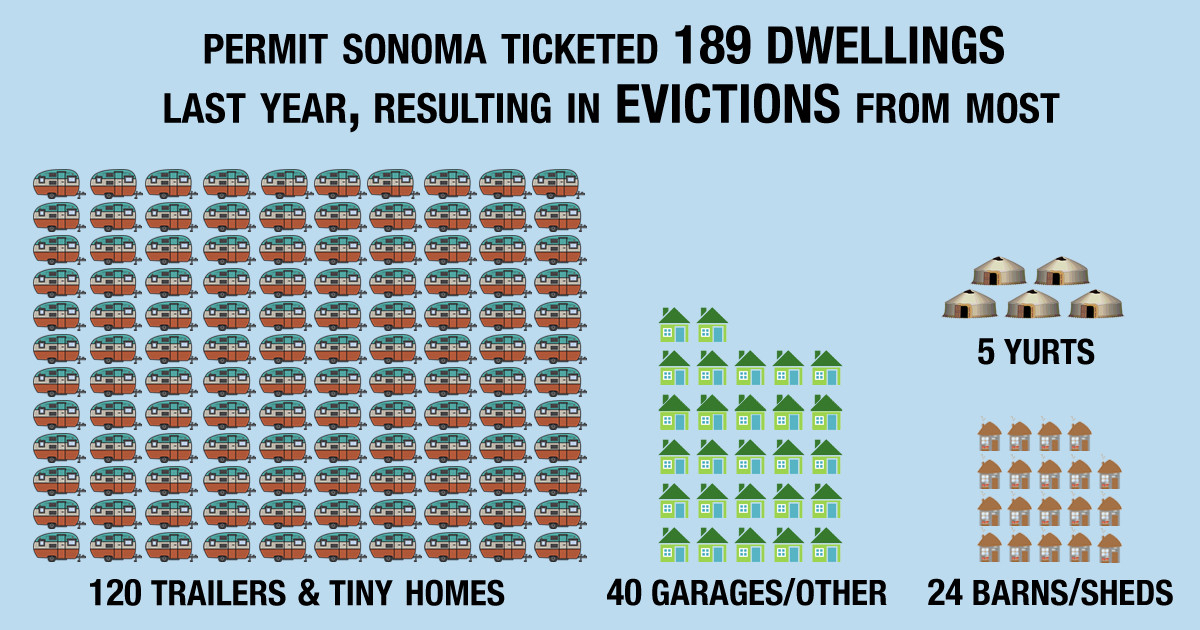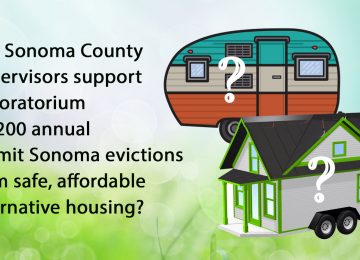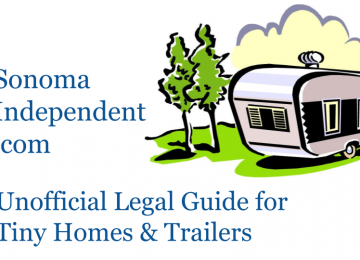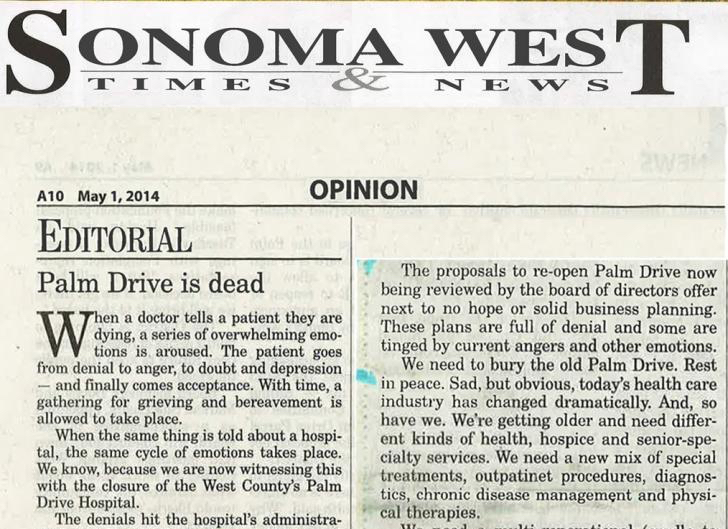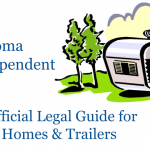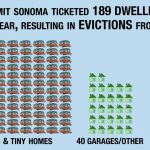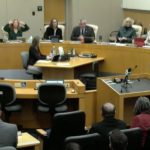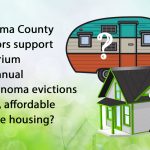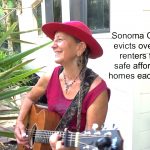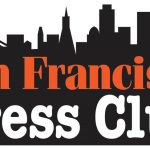A three month long investigation initiated by Sonoma Independent, the award-winning public interest solutions and advocacy website, reveals that Permit Sonoma ordered property owners to vacate 189 inhabited dwellings between September 1, 2020 and August 31, 2021.
These citations, enforced by threats of fines of up to $100 a day and liens against properties, resulted in the eviction of more than 150 low income renters from safe trailers, converted barns, tiny homes, yurts and other modest dwellings during the past year for the simple reason that they were, in almost every case, ineligible for permits.
This means that despite an expenditure of $20 million in tax dollars to acquire and manage 75 motel rooms for the homeless last year, Sonoma County created more new homeless people than it found housing for.
The Sonoma Independent has started a grassroots Stop All Government Evictions (SAGE) campaign to urge our supervisors to reform code enforcement laws to allow people to live simply, safely and ecologically in trailers, tiny homes, yurts and converted barns.
More than 3,000 people have signed our Change.org petition, urging County Supervisors to reform a dysfunctional, antiquated system that makes our neighbors experience life-threatening homelessness for what our tax-funded government officials hypocritically claim is their own “health and safety.”
This includes Copperwoman Saso (our two minute video here or below), a 70-year old tiny home grandmother whose close friend has been ordered to evict her, and make her homeless, because she has a composting toilet in the beautiful tiny home that she owns and pays $625 a month for land rent, water and electricity. Her property owner friend tried to resist the order until she was threatened with more than $10,000 in fines last month and forced to agree to evict Saso by January 9, in the middle of winter, an act that would be illegal if it were done without being ordered by the government.
How the 189 eviction figure was derived
The Sonoma Independent investigation into Permit Sonoma’s began with a California public records request to the agency asking how many property owners were ordered to vacate unpermitted inhabited dwelling units during the past 12 months. To our surprise, we learned that neither the county’s code enforcement agency, with a budget of $3.5 million a year, nor the housing officials of the county’s Community Development Commission, with an administrative budget of $10 million per year, had ever tallied the number of people who were evicted by property owners forced to evict tenants from their unpermitted dwellings.
To find this information the Sonoma Independent analyzed the zoning enforcement orders publicly available on Permit Sonoma’s website, here. This search tool allows users to search violations issued by the agency. Unpermitted housing, such as a tiny home, travel trailer, or ADU conversion, is generally ticketed as either a planning violation (a VPL), or a building code violation (a VBU). Permit Sonoma staff confirmed that “VPLs and VBUs are violations that have been investigated and had notices issued.”
What we found searching the nearly 1700 VPL and VBU violations from September 2020 through August 2021 is that Permit Sonoma issued notices for 189 occupied unpermitted dwellings that led to the individual or residence being ordered removed from the property. The majority of these dwellings were trailers and tiny homes.
The only way for a property to reach “compliance” in order to resolve the violation, is to either obtain a permit, or evict its occupant-which is what they do more than 95% of the time. If the property owner fights the order to vacate the property, they are faced, as in Copperwoman Saso’s case, with fines of $100 per day as well as paying for the cost of a hearing.
Since the 189 dwellings issued violations don’t show a subsequent application for a permit, we can assume that the property achieved compliance via the only other way: eviction of the occupant and demolition or removal of the home from the property. A Permit Sonoma spokesman recently informed us that four units not counted in our tally of 189 had been allowed to remain occupied had received or applied for permits during this period.
Recent changes in state laws allow property owners to build auxiliary dwelling units (“ADU’s”) more easily, and trump limiting local zoning laws to encourage more housing. But these new ADU laws have absolutely nothing to do with the 189 dwellings the county orders people evicted from last year, or the 20,000 such units that people are living in right at this moment.
ADU’s must be built to housing code and acquire require permits. Property owners, most of them wealthy, typically spend hundreds of thousands of dollars to get them built and permitted. After investing large amounts of money and time, these owners generally provide the ADU units to visitors as guest cottages, rent them for Air B&B, or rent them out at far higher rents than the estimated 20,000 low income county residents who currently live in trailers, tiny homes, yurts and unpermitted dwellings are able to pay.
Permit Sonoma Denies the Consequences of Its Actions
Permit Sonoma and, sadly, a number of Sonoma County Supervisors, are in denial of the consequences that its draconian enforcement system has on human beings and the county’s affordable housing supply.
Their argument, articulated by Bradley Dunn, Policy Manager for Permit Sonoma, is that because it lacks a permit (and is, like all tiny homes, ineligible to EVER get a permit because of their structure), Saso’s comfortable dwelling, with a composting toilet, is, as he stated in an interview “not housing.”
That’s because, Dunn explained, “in order for it to be housing it has to meet the building code. Our priority is to protect people from substandard conditions that could endanger their lives.”
So by this logic, recently supported by similar statements by Supervisors Susan Gorin and James Gore, 70-year old Saso is endangering her own life by living in her own beloved home, and that she, and the thousands and thousands of Sonoma county residents similarly situated, would be safer if they were homeless!
Sonoma County’s government and its top elected officials have repeatedly stressed the need for more affordable housing to support lower income farmworker, service industry employees and young residents. Yet even with tens of millions in federal, state, local and county dollars, the County is only able to oversee the private and non profit construction of far fewer than 100 affordable homes per year on average, at a cost of about $500,000 each.
20,000 Low Income Residents Live in Fear of Being Evicted by a Neighbors Phone Call to Permit Sonoma
Meanwhile the private market has responded to the need for attainably priced rental housing by making what the Sonoma Independent estimates is more than 20,000 trailers, tiny homes and converted dwellings available to their lower income family members, friends and renters in the hundreds of thousands of sparsely populated acres in the unincorporated areas of the county.
The Sonoma Independent estimates this number by taking the 66,000 properties in the unincorporated area of the county, and estimating that one quarter of them have an average of 1.25 unpermitted dwellings on them. Given that more than 80% of the 25 property owners this reporter personally knows of each has two unpermitted dwellings, this seems like a conservative estimate. There are probably more. But nobody knows for sure, because such homes are hidden from government view, despite the fact that they provide more people with the safe, attainably priced homes that our government purportedly wants to encourage.
It is important to note that the nearly 150-plus low income renters who are evicted by Permit Sonoma are not evicted because their homes are less safe than the 20,000 other people who live in similar trailers and tiny homes. They simply are the ones whose neighbors, often arbitrarily, have chosen to call Permit Sonoma to complain.
Simple Housing is Not Substandard or Unsafe Housing
Permit Sonoma and the state housing code considers any building or residence that has not gone through the permitting process are “substandard” and unsafe.
But the reality is that the existence of 20,000 trailers and tiny homes belies the county’s claims that unpermitted dwellings are unsafe. If they were unsafe, there would be continual fires and e. Coli outbreaks impacting hundreds, or at least dozens of people. But year after year there have been no reports of such injuries.
RV trailer toilet systems are permitted in campgrounds and on some city streets, like Seabstopol’s Morris Avenue, where homeless people are forced to park them. Composting toilets are legal in eight states, without any evidence of harm. Permit Sonoma, after three months, has never responded to this reporter’s California Public records request that the agency provide a single specific example of county illness caused by a composting toilet. This month the Sonoma Independent reported on the ecological, water-saving advantages, and safety, of composting toilets like Copperwoman Saso’s here.
Supervisor Lynda Hopkins, has tried, without success, to curb Permit Sonoma’s relentless campaign of vacate orders resulting in the eviction of low income renters across the county. She supports the SAGE campaign effort, which will ramp up in January, to lobby our supervisors to pass a new policy ordinance allowing people to live in simple unpermitted dwellings if those structures were otherwise safe.
“Our office has been working on half a dozen different cases where we’re trying to keep people in their homes, where we don’t want to Permit Sonoma to kick them out,” Hopkins said. “I am all in on this. I have been dealing with this ever since I took office.”
“It just breaks your heart: really, are you kidding me?” Supervisor Lynda Hopkins observed. We’re shutting someone out of a perfectly habitable dwelling because some zoning code prohibits it and some new neighbor has complained and suddenly they’re going to be homeless when in some cases they have lived there for 20 or 30 years.”
Sonoma County Homeless Action, in a press release calling Permit Sonoma actions “shameful,” has joined the effort to allow unpermitted people to not be evicted from their modest dwellings as long as they are, like Copperwoman Saso’s, otherwise safe.
Regulations are necessary, but when they become disconnected from reality, they need to be reevaluated. In this case, the policies of Permit Sonoma are aggravating the housing crisis by taking low income housing off the market while causing serious harm to hundreds of individuals every year.
The Board of Supervisors has the ability to reevaluate these policies and find a solution to keep people in their homes. There are a number of solutions available to elected officials, from changing the regulations themselves, reducing fines to a nominal amount, allowing trailers and tiny homes to be permitted inexpensively with existing composting or trailer toilet systems, or enacting a moratorium on evictions. But the biggest impediment to finding a solution seems for our government to be acknowledge that this problem exists at all.


